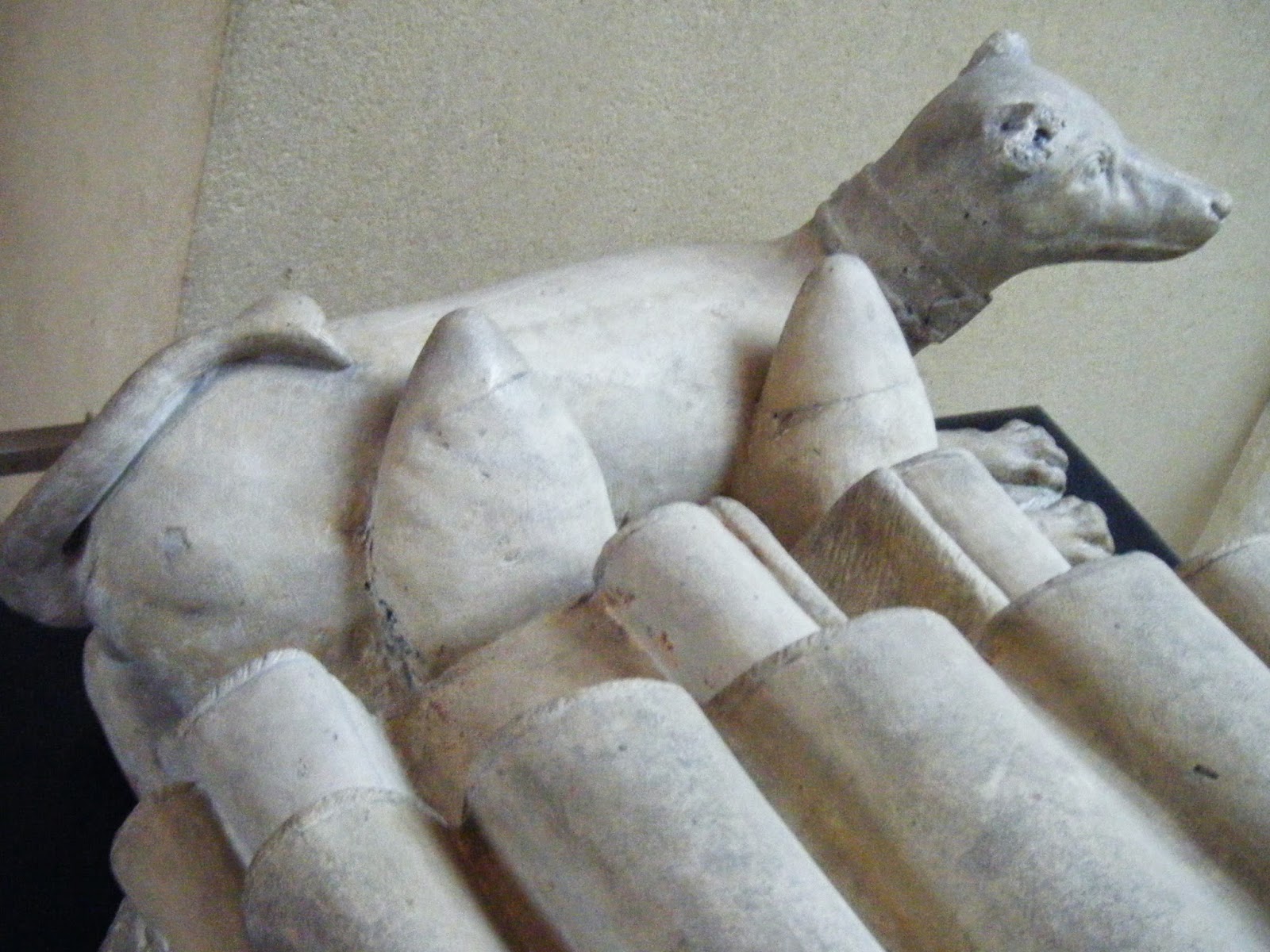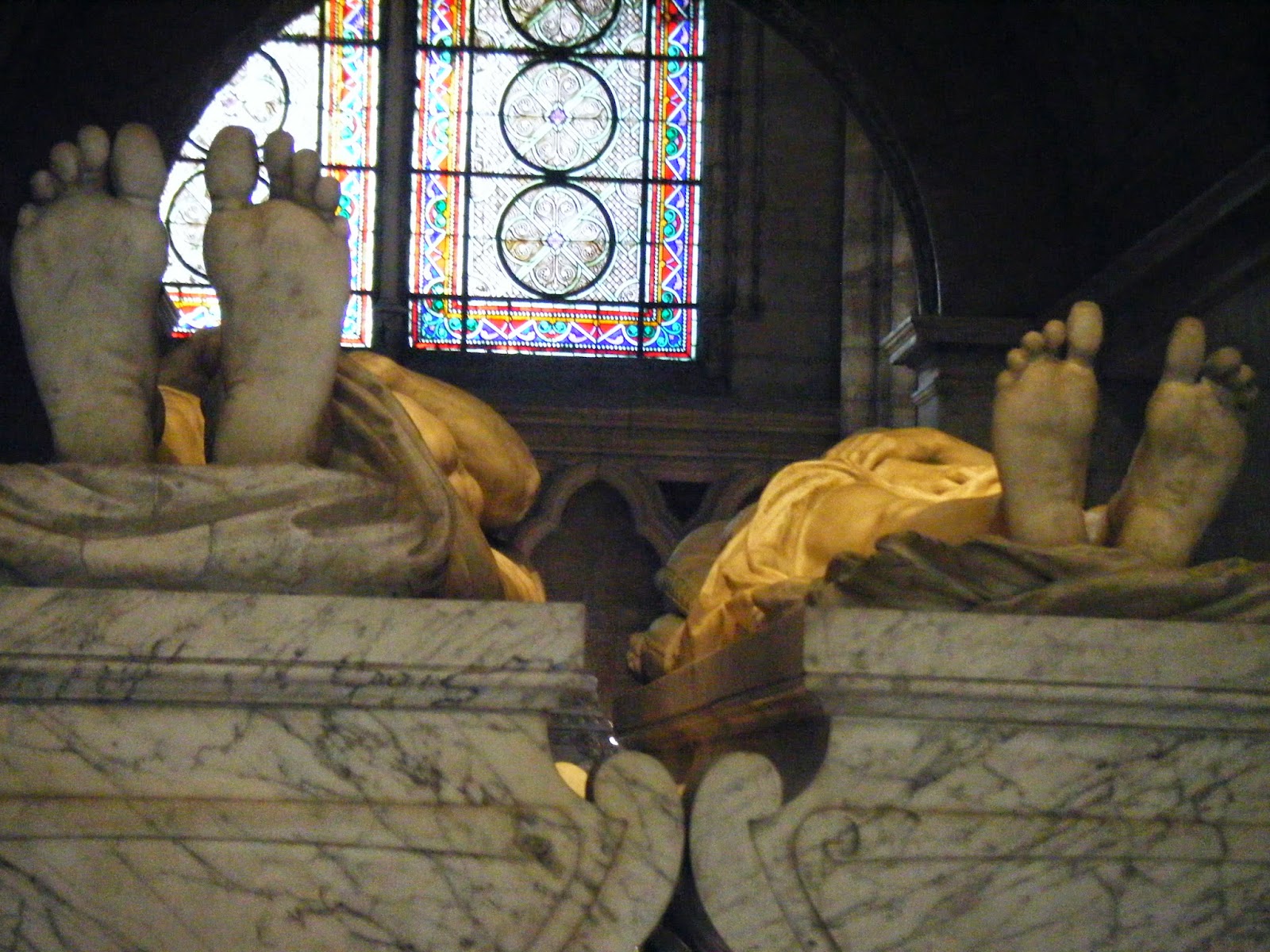No man can escape the transience of his time on earth nor the inevitability of death, yet that has never prevented reflection on the matter, nor its representation in the arts.
Different stages of the departure from the terrestrial and passage to the celestial have been portrayed in a multitude of manners, in painting, frescoes, illuminated manuscripts, stained glass, carving and sculpture. These go from the subtlest of forms to the downright macabre, all in accordance with the vision of mortality, death and spirituality of the time.
Of all the symbols that serve to highlight the importance of a man's earthly life and guide him towards his spiritual life after death, I have my favourite; the creatures that appear at the foot of the tomb. Of course, this was symbolism reserved for the most affluent and important members of society, those with the privilege of a tomb rather than a mass grave.
The use of wonderful beasts to serve as footrests for the recumbent figures of the departed flourished over the extensive Gothic period.
The sculpted forms of lions, dogs, unicorns, dragons and eagles would appear in the cathedrals, churches and basilicas around Europe, doggedly poised at the foot of the effigies of kings, queens, high-ranking clergy and the aristocracy.
I came across the examples here in both France and England. Gothic art arose from the Basilica cathedral of Saint Denis in Ile-de-France in the 12th century.
The Gothic Rayonnant style that developed there subsequently became a point of reference for all religious architecture and its aesthetic influence fanned out across Europe.
Not only was Saint Denis a place of pilgrimage, more importantly it was the sacred burial site for kings. Just as the cathedral of Reims, La cité des Sacres , was devoted to the coronation of the monarchy, Saint Denis was their final earthly resting-place.
For centuries Saint Denis was the royal necropolis of France; during the Revolution years the site paid a heavy price for these same regal associations.
Despite the ravages of the Revolution years, a cortege of lifeless forms lay peacefully on the tombs placed around the cathedral, seemingly unaware and unperturbed by the turmoil that had raged around them.
Unlike the gruesome realism of the cadaver tomb monuments of later periods towards the 15th century, the earlier Gothic effigies did not dwell on the macabre.
Rather than serving as a gloomy reminder of the brevity and hardships of man's existence, the Gothic gisant forms present the departed as merely asleep, in a state of eternal repose.
This is far removed from the later transi forms that show the mortal, however noble his birth, just after the death throes or in a state of decomposition. In Saint Denis, the earlier gisant figures can be seen alongside the more tormented, grim transi.
Many of the late cadaver tomb monuments are presented in a two-tier composition. The sad, mortal remains of the transi lay exposed on a cold slab, below the top layer that bears the deceased as orant, devoutly kneeling in prayer.
Although such monuments have a certain gruesome attraction, the comparative innocence and restful nature of the Gothic gisant has a greater hold.
Funeral art reflected the departure from the tendency of burying the dead with material goods to testify to their worldly importance and accompany them on their journey to the other side. The tombs of the deceased were given symbolic references that celebrated the worth, and directly or indirectly, the wealth of their 'residents'.
The forms of the gisants were relatively uniform; figures laying flat, head facing up, hands across the chest in prayer or perhaps bearing a symbolic object. Realism in facial expression was developed as individual likeness became more apparent over time, but this did not detract from the reposeful aura of the deceased.
Looking at the pale stone effigies today, it is difficult to imagine that these were once highly coloured, as was the majority of cathedral and church stonework in the Middle Ages.
Generally speaking, garments tended to be fairly uniform, yet attention was paid to voluminous folds and pleats in the clothing. Regal, heraldic and ecclesiastic insignia were likewise mostly modest, as scepters, shields and staffs were lain on the recumbent forms.
The feet themselves were shown wearing either supple cloth slippers, or rather more pointed varieties, or even the spurred and spiked armoured shoes of the knights.
Perhaps the greatest departure from this sober conformity of attire were the creatures upon which such footwear often reposed.
From the second and third quarter of the 13th century (approx 1225-1250), at least one in four prestigious tombs bore animal supports. High-relief tombs with their effigies perhaps offered rather more opportunity for decoration than the flatstone 2-dimensional variety.
Certainly, the sculptors seem to have taken great relish in the representation of the creatures that accompany and guard over their human masters. Although these beasts appear less on the tombs of ecclesiastic figures than on other illustrious members of the land, there are otherwise few restrictions. Rather animated and stylized animal effigies curl around the feet of men and women alike.
Two different animals could appear at the feet of the same individual, however there were rarely more than two creatures. Frequently there would be simply one sole creature supporting the feet of the departed.
Apart from the lion, no beast was gender-specific, reserved for solely male or female beneficiaries. While the figure of the dog was the most common form employed for its symbolic notions of loyalty and courage in the masculine gisant , it also appeared as a tribute to the fidelity displayed by devoted female spouses. The loyal gaze such dogs often direct at their master or mistress is further testament to their devotion.
With their eyes wide open, bells safely attached to their collars, they keep vigil, looking on, often to comic effect. Sometimes, the dog may seem distracted by other canine pursuits, such as hunting interests, but it holds its appointed position or is held down by the weight of the master's feet. All serve to guide in the transition between Life and Death, light and darkness, but may also reflect social class and distinction.
Of the various different categories of dog to be observed (chien allant, chien couchant, chien d'Oysel) the greyhound best represents nobility and obedience. The lion reflects similar characteristics and its presence grew increasingly common, alongside, or in place of the canine figure. Unlike the dog, the king of the beasts is not always presented at foot level, and does not generally look up its master in adoration. Instead the lion may gnaw on a bone, or proudly place its imposing paws on a heraldic shield, reflecting the force and power of its regal charge.
In legend, the lion is capable of sleeping with its eyes open and therefore nothing escapes its watchful stare. Symbolizing mastery of Life over Death through resurrection and faith over sin, through St Mark, the lion reigned over effigy sculpture in the latter part of the 13th century. For the most part majestic, perhaps even haughty, the occasional lion figure reveals other characteristics that are a little less regal. I like these the most!
Dragons too, appear from time to time, symbolizing valour and protection. Vanquished by the triumphant St Michael, the king of the serpents is frequently presented as two-headed beast, complete with pointed beak and deadly talons. Again, the ferocious nature of the creature is sometimes belied by the strangest of expressions.
The bear, symbol of strength and healing, also seems to assume an image of gentleness in certain gisant sculptures. Meanwhile, the purity of the unicorn is rarely questioned, yet certain portrayals appear comic in their earnestness. As symbol of innocence, grace and divinity, the unicorn was often used to adorn the gisant tomb of the chaste.
Without a doubt, the most eerie of all the presentations here are those where the feet are dismally shrouded, or simply bare, literally without any creature comfort...
These are all too cold and 'down-to-earth'; I much prefer man and his odd beasts in all their finery...


































No comments:
Post a Comment
Leave a message - please share your ideas!